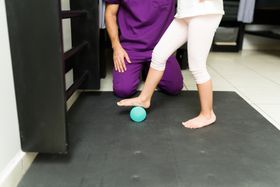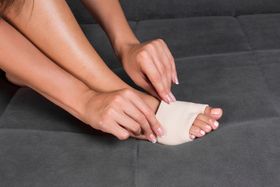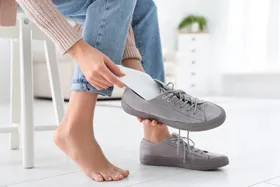Corns vs. Bunions: Similarities and Differences
Updated January 30, 2024.

The common thing about corns and bunions is how both the conditions' symptoms are the same, and often thought to be the same thing. However, these two conditions are different, requiring different approaches in conservative and medical management strategies.
Corns are associated with thickening of the skin, often due to repetitive rubbing and pressure placed on the skin on the underside or top of the foot. Bunions are characterized by a noticeable alignment shift of the big toe outwards towards the smaller toes of the foot.
Pain is often experienced at the site of the inwardly bent big toe joint, commonly associated with the progression of the condition. Bunions present with a visible bump around the joint, at the base of the big toe. Bunions are caused by genetic inheritance, ligament laxity, flat feet, and abnormal foot structure.
» Looking to prevent corns and bunions? Take a look at some of the best insoles for flat feet to provide support and avoid these conditions
What Are Corns?
Corns are thickened layers of hard skin that arise as a result of the body trying to protect itself from regular friction and rubbing. The skin may become dry or flaky as a result of corn formation in an area. Pain or tenderness is a common symptom when applying pressure directly onto a corn or callus.
The symptoms of corns include:
- Thickened, hardened skin under high-pressure areas.
- Change of skin color in the callused skin.
- Tenderness under a touch.
What Are Bunions?
A bunion or hallux valgus is a marked inward turn of the big toe towards the other toes, with a bony bump on the inner side of the foot. Pain and inflammation are some early signs of bunions that can occur on the side of the bone bump as the condition gets progressively worse, without effective conservative management strategies.
Bunions can be caused by altered mechanics of the foot seen in conditions like flat feet, and can also be caused by tight shoes that crowd the toes while wearing them.
The symptoms of bunions include:
- Visible change of direction of the big toes towards the smaller toes.
- Pain and soreness around the bony bump around the big toe joint.
- Joint stiffness.
- Redness or minor swelling around the joint deformity.
- Difficulty walking.
- Callus formation, usually around the underside of the big toe.
Take a look at our post on how you can prevent bunions from worsening.
Corns vs. Bunions: What Are the Similarities?
The similarities between the two conditions are the noticeable thickening of the skin around the areas of most friction between the foot and shoe. The skin thickens around the area of the bunion, and the skin thickens around the pressure area in corns.
Both conditions usually arise and progress slowly over time and are often linked to tight-fitting shoes with a narrow toe box. Both conditions are made worse by activity and can produce pain in severe cases.
These conditions in severe cases can be managed with surgical intervention. Due to these conditions, there may also be a need for arch support insoles. Wearing arch supports has been proven to be beneficial to people with these conditions.
Corns vs. Bunions: What Are the Differences?
The major difference between the two conditions is that bunion development affects the bone structure and alignment in the foot, while the other is associated with the thickening of the skin and no alterations to the bone structure of the foot.
Corns usually present as the body’s reaction to friction in an area to prevent blister formation and are not known as an inheritable trait. Bunions can be inherited as a genetic trait, however, and can be caused by factors such as ligament laxity and flat feet, amongst others. The treatment for the two conditions varies between the conditions, as seen below.
Treatment for Corns and Bunions
Treatment for corns or calluses involves removing the hard skin by a trained medical professional or podiatrist. Any underlying reasons for corn development can also be ruled out by the doctor during this process. You can enquire with the doctor about how to prevent further corn formation.
Treatment for bunions makes use of orthotic devices or inserts (such as bunion pads) to correct and support the foot through weight-bearing activities, preventing the progression of the condition.
Orthotics for bunions aim to redistribute the weight through the entirety of the foot, reducing the weight translated through the forefoot while walking or running. Though it is not completely possible to fix bunions without surgery, there are conservative approaches that help reduce pain and swelling.
Toe separators can also be used to maintain the alignment of the big toe during these activities, and are a cost-effective way to manage bunions safely.
For both conditions, if a reduction in daily mobility is seen due to pain or stiffness in the foot, it is advised you seek medical advice regarding this. In severe cases of both conditions, the doctor might suggest a surgical intervention to manage these conditions.








